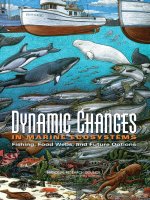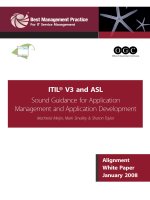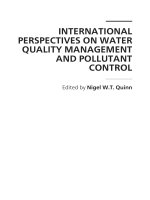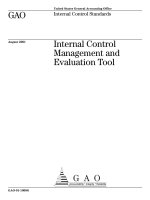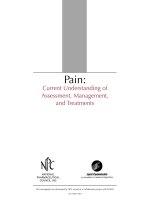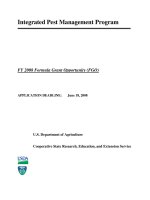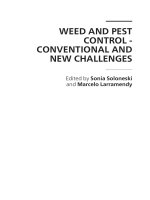INTEGRATED PEST MANAGEMENT AND PEST CONTROL – CURRENT AND FUTURE TACTICS docx
Bạn đang xem bản rút gọn của tài liệu. Xem và tải ngay bản đầy đủ của tài liệu tại đây (31.68 MB, 682 trang )
INTEGRATED PEST
MANAGEMENT AND
PEST CONTROL – CURRENT
AND FUTURE TACTICS
Edited by Marcelo L. Larramendy
and Sonia Soloneski
Integrated Pest Management and Pest Control – Current and Future Tactics
Edited by Marcelo L. Larramendy and Sonia Soloneski
Published by InTech
Janeza Trdine 9, 51000 Rijeka, Croatia
Copyright © 2012 InTech
All chapters are Open Access distributed under the Creative Commons Attribution 3.0
license, which allows users to download, copy and build upon published articles even for
commercial purposes, as long as the author and publisher are properly credited, which
ensures maximum dissemination and a wider impact of our publications. After this work
has been published by InTech, authors have the right to republish it, in whole or part, in
any publication of which they are the author, and to make other personal use of the
work. Any republication, referencing or personal use of the work must explicitly identify
the original source.
As for readers, this license allows users to download, copy and build upon published
chapters even for commercial purposes, as long as the author and publisher are properly
credited, which ensures maximum dissemination and a wider impact of our publications.
Notice
Statements and opinions expressed in the chapters are these of the individual contributors
and not necessarily those of the editors or publisher. No responsibility is accepted for the
accuracy of information contained in the published chapters. The publisher assumes no
responsibility for any damage or injury to persons or property arising out of the use of any
materials, instructions, methods or ideas contained in the book.
Publishing Process Manager Maja Kisic
Technical Editor Teodora Smiljanic
Cover Designer InTech Design Team
First published February, 2012
Printed in Croatia
A free online edition of this book is available at www.intechopen.com
Additional hard copies can be obtained from
Integrated Pest Management and Pest Control – Current and Future Tactics, Edited by
Marcelo L. Larramendy and Sonia Soloneski
p. cm.
ISBN 978-953-51-0050-8
Contents
Preface XI
Part 1 Integrated Pest Management – Theory and Concepts 1
Chapter 1 Principles and Practices of Integrated Pest Management
on Cotton in the Lower Rio Grande Valley of Texas 3
Shoil M. Greenberg, John J. Adamczyk and John S. Armstrong
Chapter 2 Toward the Development of Novel Long-Term Pest
Control Strategies Based on Insect Ecological
and Evolutionary Dynamics 35
René Cerritos, Ana Wegier and Valeria Alavez
Chapter 3 Agroecological Crop Protection:
Concepts and a Case Study from Reunion 63
Jean-Philippe Deguine, Pascal Rousse and Toulassi Atiama-Nurbel
Chapter 4 Quantifying the Effects of Integrated Pest
Management in Terms of Pest Equilibrium Resilience 77
Kevin L. S. Drury
Chapter 5 Manipulation of Natural Enemies in Agroecosystems:
Habitat and Semiochemicals for
Sustainable Insect Pest Control 89
Cesar Rodriguez-Saona, Brett R. Blaauw and Rufus Isaacs
Chapter 6 Grafts of Crops on Wild Relatives as
Base of an Integrated Pest Management:
The Tomato Solanum lycopersicum as Example 127
Hipolito Cortez-Madrigal
Chapter 7 Techniques to Estimate Abundance and
Monitoring Rodent Pests in Urban Environments 147
Regino Cavia, Gerardo Rubén Cueto and Olga Virginia Suárez
VI Contents
Chapter 8 Insectigation in Vegetable Crops:
The Application of Insecticides Through
a Drip, or Trickle, Irrigation System 173
Gerald M. Ghidiu
Chapter 9 Generalist Predators, Food Web Complexities
and Biological Pest Control in Greenhouse Crops 191
Gerben J. Messelink, Maurice W. Sabelis and Arne Janssen
Chapter 10 Feral Pigeons: Problems,
Dynamics and Control Methods 215
Dimitri Giunchi, Yuri V. Albores-Barajas, N. Emilio Baldaccini,
Lorenzo Vanni and Cecilia Soldatini
Chapter 11 Biological Control of Dengue Vectors 241
Mario A Rodríguez-Pérez, Annabel FV Howard
and Filiberto Reyes-Villanueva
Chapter 12 Fruit Flies (Diptera: Tephritoidea):
Biology, Host Plants, Natural Enemies,
and the Implications to Their Natural Control 271
M. A. Uchôa
Chapter 13 From Chemicals to IPM Against the Mediterranean
Fruit Fly Ceratitis capitata (Diptera, Tephritidae) 301
Synda Boulahia Kheder, Imen Trabelsi and Nawel Aouadi
Part 2 Integrated Pest Management – Current Applications 321
Chapter 14 Bark Beetles Control in Forests of Northern Spain 323
Arturo Goldazarena, Pedro Romón and Sergio López
Chapter 15 Biological Studies and Pest Management
of Phytophagous Mites in South America 353
Carlos Vásquez, José Morales-Sánchez, Fernando R. da Silva
and María Fernanda Sandoval
Chapter 16 Research on One Kind of Essential Oil Against
Drugstore Beetle Stegobium paniceum (L.) 377
Can Li
Chapter 17 Integrated Pest Management of Eucalypt
Psyllids (Insecta, Hemiptera, Psylloidea) 385
Dalva Luiz de Queiroz, Daniel Burckhardt and Jonathan Majer
Chapter 18 Biological and Ecological Studies
on Land Snails and Their Control 413
Ahmed Sallam and Nabil El-Wakeil
Contents VII
Chapter 19 Bacillus thuringiensis –
Based Biopesticides Against
Agricultural Pests in Latin America 445
Ricardo Antonio Polanczyk, Sergio Antonio De Bortoli
and Caroline Placidi De Bortoli
Chapter 20 Baculoviruses: Members of Integrated
Pest Management Strategies 463
Vanina Andréa Rodriguez, Mariano Nicolás Belaich
and Pablo Daniel Ghiringhelli
Chapter 21 Recent Advances in Our Knowledge of Baculovirus
Molecular Biology and Its Relevance for the
Registration of Baculovirus-Based Products for
Insect Pest Population Control 481
Renée Lapointe, David Thumbi
and Christopher J. Lucarotti
Part 3 Integrated Pest Management – Future Challenges 523
Chapter 22 Wheat Midges and Thrips
Information System:
Decision Making in Central Germany 525
Nabil El-Wakeil, Nawal Gaafar, Mostafa El-Wakeil
and Christa Volkmar
Chapter 23 Role of GPI-Anchored Membrane Receptors in
the Mode of Action of Bacillus thuringiensis Cry Toxins 551
Fernando Zúñiga-Navarrete, Alejandra Bravo, Mario Soberón
and Isabel Gómez
Chapter 24 Evaluating Surface Seals in Soil Columns to
Mitigate Methyl Isothiocyanate Volatilization 567
Shad D. Nelson, Catherine R. Simpson, Husein A. Ajwa
and Clinton F. Williams
Chapter 25 Transgenesis, Paratransgenesis and
Transmission Blocking Vaccines to
Prevent Insect-Borne Diseases 581
Marcelo Ramalho-Ortigão
and Iliano Vieira Coutinho-Abreu
Chapter 26 Essential Oils of Umbelliferae (Apiaceae)
Family Taxa as Emerging Potent
Agents for Mosquito Control 613
Epameinondas Evergetis, Antonios Michaelakis
and Serkos A. Haroutounian
VIII Contents
Chapter 27 Flourensia cernua DC: A Plant from Mexican
Semiarid Regions with a Broad Spectrum
of Action for Disease Control 639
Diana Jasso de Rodríguez, F. Daniel Hernández-Castillo,
Susana Solís-Gaona, Raúl Rodríguez- García
and Rosa M. Rodríguez-Jasso
Chapter 28 Advances in Aerial Application Technologies and
Decision Support for Integrated Pest Management 651
Ian M. McLeod, Christopher J. Lucarotti, Chris R. Hennigar,
David A. MacLean, A. Gordon L. Holloway, Gerald A. Cormier and
David C. Davies
Preface
Pests have always represented one of the key limiting factors in crop production. For
the first time in human history, we are technically able to produce as much food as
needed for the ever increasing world population, thus theoretically eliminating the
risk of food crisis. Since the beginning of the humanity, pesticides have revolutionized
pest control to protect its food source. The first known pesticide was elemental sulfur
dusting used in ancient Sumer about 4,500 years ago in ancient Mesopotamia. Toxic
chemicals such as arsenic, mercury and lead were being applied to crops to kill pests
by the 15th century whereas nicotine sulfate was extracted from tobacco leaves for use
as an insecticide during the 17th century. Nowadays, it is commonly accepted that the
increase in food production worldwide has led to employ large amounts of pesticides.
Although the benefits of conventional food production practices have been immense,
they utilize levels of pesticides and fertilizers that can result in a detrimental impact
factor on the environment. Pesticides are high volume, widely used environmental
chemicals and there is continuous debate concerning their probable role in both acute
and chronic human health effects. Latest report of the United States Environmental
Protection Agency -USEPA- disclaimed that the world pesticide market estimation
usage only for the 2006-2007, was nearly over 5.2 billion pounds. Their application is
still the most effective and accepted method for plant and animal protection from a
large number of pests, being the environment consequently and inevitably exposed to
these compounds. The goal in pesticide investigation and development is identifying
the specificity of action of a pesticide toward the organisms it is supposed to kill only
the target organisms should be affected by the application of the product. However,
because pesticides are designed and selected for their biological activity, toxicity on
non-target organisms, including humans, frequently remains a significant potential
risk. The benefits in using pesticides must be weighed against their deleterious effects
on human health, biological interactions with non-target organisms, pesticide
resistance and/or accumulation of these chemicals in the environment.
Integrated Pest Management -IPM- traces its first real beginnings to the late 1960s,
where a number of factors were associated to initiate a search for better methods of
pest control rather than the reliance on pesticide use. Among these factors are
included not only the very well known problems related to pesticide use, abuse, and
misuse, but also the rapid development of new technologies enabling more
XII Preface
sophisticated approaches, primarily due to the overwhelming advances in
communication and computational tools, with the allied new sciences of operations
research, systems analysis, and modeling. As defined by the USEPA, IPM is an
effective and environmentally sensitive approach to pest management that relies on a
combination of common-sense practices. IPM programs use current and
comprehensive information on the life cycles of pests and their interaction with the
environment. This information, in combination with available pest control methods, is
used to manage pest damage by the most economical means, and with the least
possible hazard to people, property, and the environment.
IPM is not a single pest control method but, rather, a series of pest management
evaluations, decisions and controls. The methodology includes four major steps,
namely: a) set action thresholds, a point at which pest populations or environmental
conditions indicate that pest control action must be taken; b) monitoring and pest
identification, so that appropriate control decisions can be made in conjunction with
action thresholds as well as to remove the possibility that pesticides will be used when
they are not really needed or that the wrong kind of pesticide will be used; c)
prevention, to manage the crop, lawn, or indoor space to prevent pests from becoming a
threat; d) control, evaluating the proper method for balancing both effectiveness and risk.
Increasing number of scientific reports within the complex IPM came out in the last
years. A simple search in a databank as Scopus, displays more than 5,600 reports
published in scientific journals from which approximately 4,400 have been reported
during the last decade. As developments in this field have been quite rapid, we believe
the writing of a new book scoping the subject is fully justified. To tackle among others,
related geopolitical, economical and population issues in our modern, cloud
computing-economy connected societies, we aim to present a more holistic approach
of the matter, in order to appreciate the full scope of the question.
Many researchers have contributed to the publication of this book. The editors hope
that this book will continue to meet the expectations and needs of all interested in pest
management to minimize the use, abuse and misuse of pesticides.
Marcelo L.
L
arrame
ndy
and Sonia Soloneski
Faculty of Natural Sciences and
M
u
s
eu
m
National University of La Plata
Ar
gentina
Part 1
Integrated Pest Management –
Theory and Concepts

